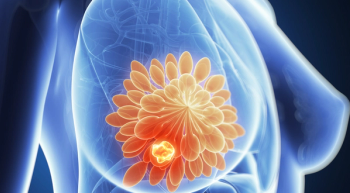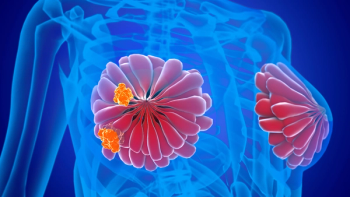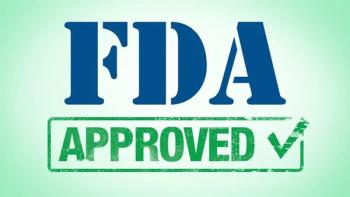
Cretostimogene Grenadenorepvec Yields Durable Response in NMIBC
Cretostimogene grenadenorepvec showed complete response across subgroups in patients with high-risk BCG-unresponsive non-muscle invasive bladder cancer.
Intravesical cretostimogene grenadenorepvec (CG0070) demonstrated high efficacy and tolerability in heavily pretreated patients with high-risk BCG-unresponsive non-muscle invasive bladder cancer (NMIBC) with carcinoma in situ (CIS), per data presented at the 2025 American Urological Association Annual Meeting from cohort C of the phase 3 BOND-003 trial (NCT04452591).1
Findings revealed that, at a data cutoff of March 14, 2025, the complete response (CR) rate in the overall patient population was 75.5% (95% CI, 66.3%-83.2%; n = 83). At a landmark of 12 months, the CR rate among 110 patients was 46.4% (95% CI, 36.9%-56.1%); the CR per a Kaplan-Meier estimate was 50.7% (95% CI, 40.9%-59.8%). At the 24-month CR landmark, the CR rate among 101 evaluable patients was 33.7% (95% CI, 24.8%-43.8%), with 9 ongoing CRs that have yet to reach the 24-month assessment. The Kaplan-Meier estimated 24-month CR was 42.3% (95% CI, 32.7%-51.6%). Of note, all CRs were centrally confirmed, with local to central concordance in 96.3% of assessments.
“Cretostimogene offers a highly effective, well-tolerated and durable treatment option for patients with NMIBC that's unresponsive to BCG,” Mark D. Tyson, MD, MPH, a urologic oncologist at the Mayo Clinic in Phoenix, Arizona, said in a presentation of the data. “It's scalable in everyday urology practice with a very familiar workflow, administered by the nurses, and its mechanism of action allows for it to be used either as a monotherapy or in rational drug combinations. I certainly look forward to future trials building on that foundation of the bladder-sparing landscape.”
Background and Design of the BOND-003 Trial
In January 2024, the FDA granted fast track and breakthrough therapy designations to cretostimogene grenadenorepvec as a potential therapeutic option for patients with high-risk BCG-unresponsive NMIBC with CIS, with or without Ta or T1 tumors.2 This regulatory decision was supported by findings from the BOND-003 trial.
The open-label, single-arm study evaluated cretostimogene monotherapy in patients with pathologically confirmed high-risk BCG-unresponsive
Eligible patients underwent weekly induction for 6 weeks; nonresponders received a second weekly induction for 6 weeks. Patients then received a maintenance course weekly for 3 weeks, followed by once every 3 months during the first year and weekly for 3 weeks once every 6 months for 2 to 3 years thereafter. The primary end point of the study was CR at any time; secondary end points include CR at 12 months, duration of response (DOR), recurrence-free survival, progression-free survival, cystectomy-free survival, and safety.
Among the 112 patients on the study, the median age was 74.0 years (range, 43-90) and the mean age was 72.9 years (SD, 9.19). The majority of patients were male (74.1%). Notably, the median number of prior instillations regarding BCG history was 12 (range, 7-66). The T-stage at study entry included CIS with high-grade Ta/T1 (19.6%) and CIS alone (80.4%). A total of 47.3% of patients received 1 or more prior therapies. Prior therapies other than BCG included serial adjuvant chemotherapy (30.4%), and systemic immunotherapy (6.3%).
Additional Efficacy Data
At 24 months, 97.3% of patients (n = 110) were free from progression to MIBC, and 84.5% avoided radical cystectomy. However, 82.4% of those who received radical cystectomies (n = 17) were T0 or NMIBC at this time. Of note, cretostimogene showed a best-in-class DOR in patients with high-risk BCG-unresponsive NMIBC, with an estimated DOR probability of 64.1% (95% CI, 52.4%-73.7%) at 12 months. At 24 months, the estimated DOR probability was 58.3% (95% CI, 46.3%-68.5%). At a median follow-up of 22.3 months, the median DOR was 27.9 months and is ongoing (95% CI, 14.3-not evaluable). Moreover, 91% of patients who achieved a CR at 12 months are projected to maintain their CR at 24 months. This suggests that the agent’s mechanism of action is innate to adaptive switching with immunogenic memory and a long immuno-oncology tail, investigators noted.
Responses were sustained over 45 months, with 50.0% of patients reinduced with oncolytic immunotherapy converted to CR. Of these patients, 64.3% had a
Across patient subgroups—including those previously treated with chemotherapy—CR rates were consistently high. The subgroups included patients who had prior intervening therapy other than BCG (75.0%; 95% CI, 61.05%-85.97%); did not receive prior intervening therapy other than BCG (75.9%; 95% CI, 62.83%-86.13%); had CIS alone at study entry (77.3%; 95% CI, 67.11%-85.53%); CIS plus T1 disease at study entry (80.0%; 95% CI, 28.36%-99.49%); CIS plus H0 Ta/T1 disease at study entry (68.2%; 95% CI, 45.13%-86.14%); BCG refractory after prior BCG therapy (73.2%; 95% CI, 62.24%-82.36%); and BCG relapsed after prior BCG therapy (82.1; 95% CI, 63.11%-92.94%).
“We observed minimal variation in CRs across the entire cohort, regardless of the number of BCG exposures prior to cretostimogene [grenadenorepvec] exposure or baseline tumor characteristics,” Tyson said during the presentation. “CRs were robust [in various] disease states, such as BCG relapsing disease, where patients are thought to have a suppressed but intact immune system, or BCG refractory disease, where patients are thought to have an exhausted tumor microenvironment. Even those with high-risk T1 patients had excellent CRs in BOND-003.”
Safety Data
Most patients on the study experienced at least 1 any-grade treatment-related adverse effect (TRAE; 63.4%; n = 71/112). No grade 3 or higher TRAEs or treatment-related discontinuations were reported. The most common any-grade TRAEs reported in at least 10% of patients included bladder spasm (25.0%), pollakiuria (21.4%), urgency (20.5%), dysuria (16.1%), and hematuria (13.4%). Notably, the median time to TRAE resolution was 1 day. Grade 2 serious TRAEs were seen in 1.8% of patients.
References
- Tyson M. BOND-003 cohort C- a phase-3, single-arm study of intravesical cretostimogene grenadenorepvec for high-risk BCG-unresponsive NMIBC with CIS. Presented at: American Urological Association Annual Congress; April 26-29, 2025; Las Vegas, NV. P2s.
- CG Oncology receives both FDA fast track and breakthrough therapy designation for cretostimogene grenadenorepvec in high-risk BCG-unresponsive non-muscle invasive bladder cancer. News release. CG Oncology, Inc. December 5, 2023. Accessed April 26, 2025. https://cgoncology.com/cg-oncology-receives-both-fda-fast-track-and-breakthrough-therapy-designation-for-cretostimogene-grenadenorepvec-in-high-risk-bcg-unresponsive-non-muscle-invasive-bladder-cancer/
Newsletter
Knowledge is power. Don’t miss the most recent breakthroughs in cancer care.




















































































